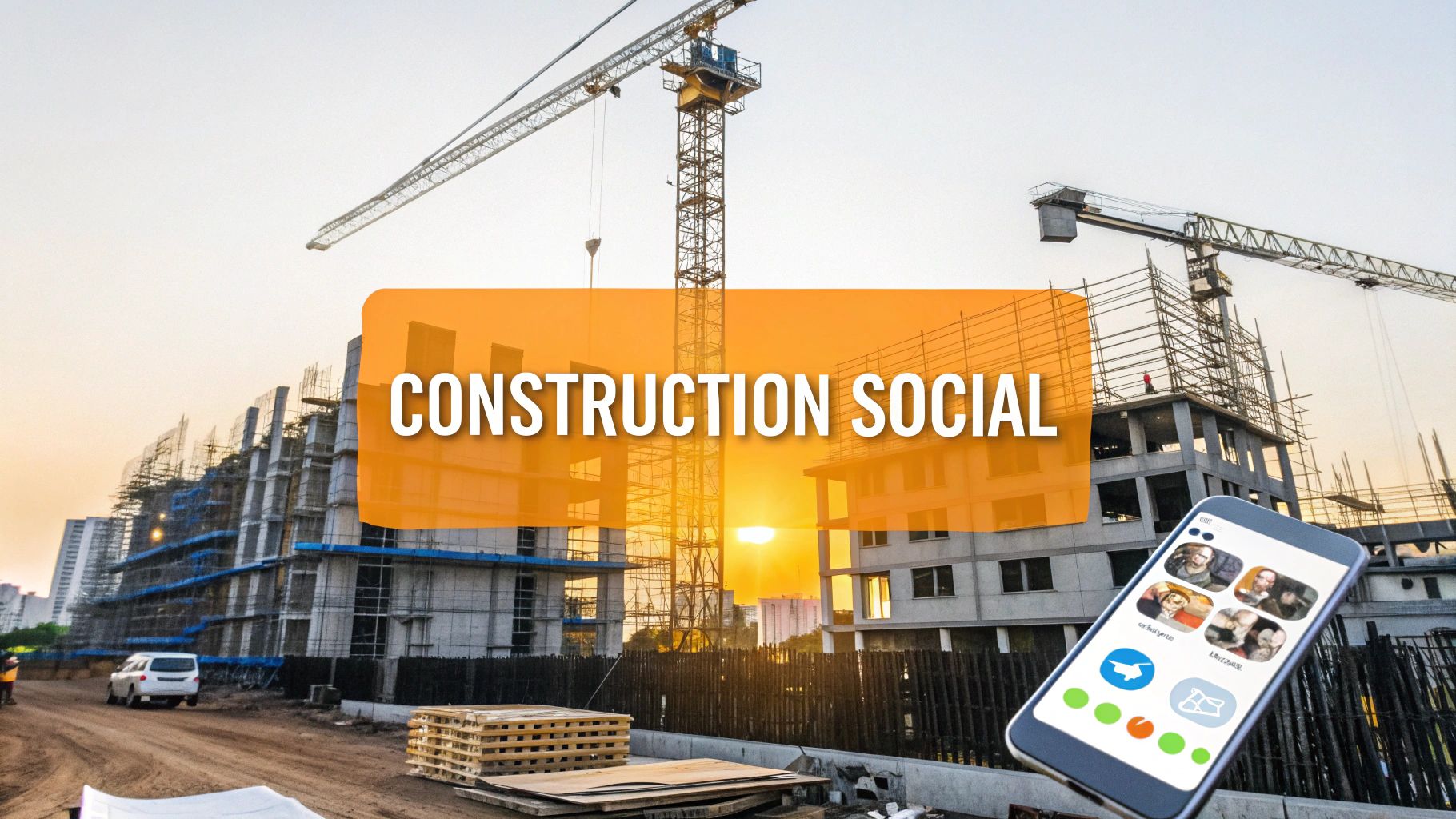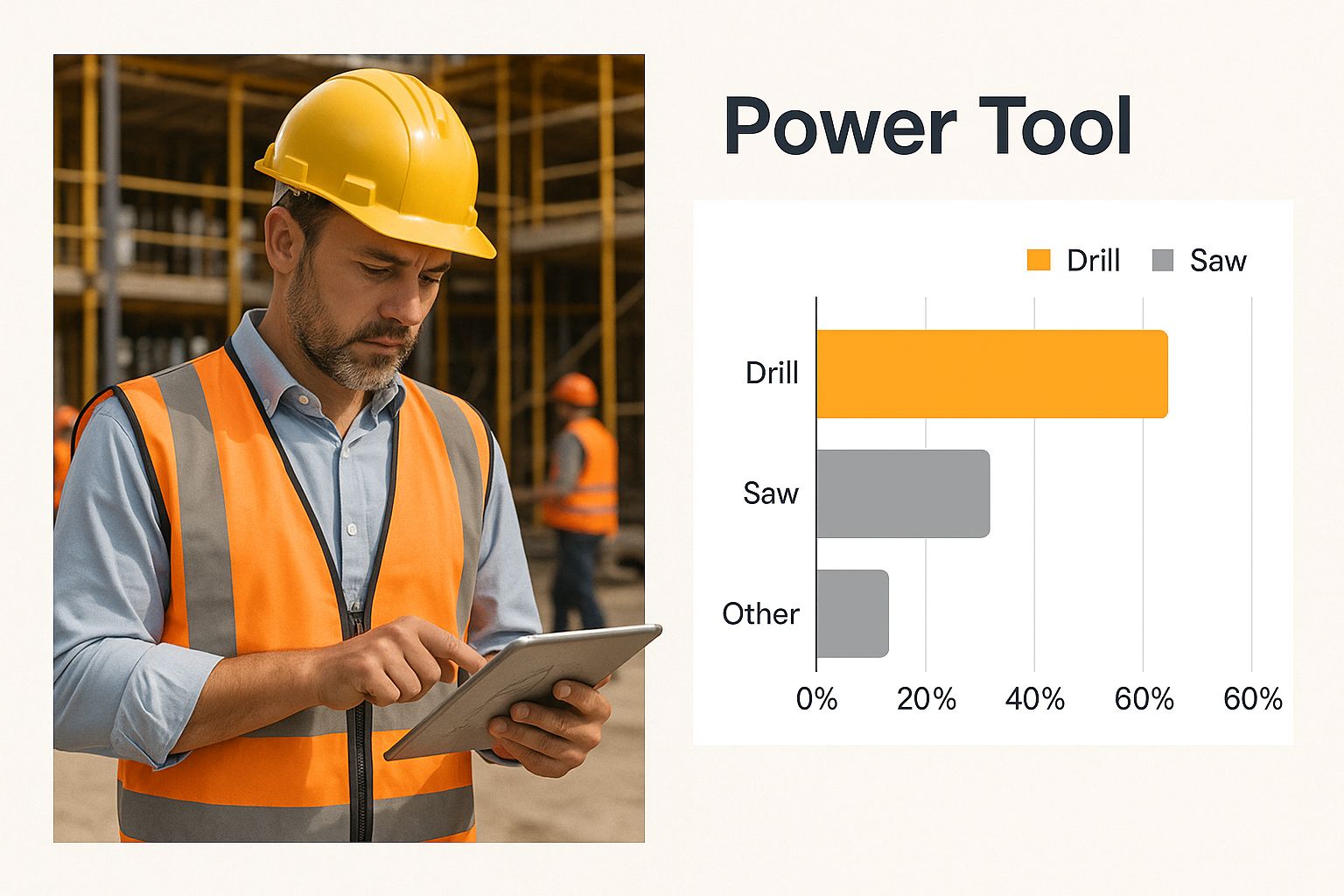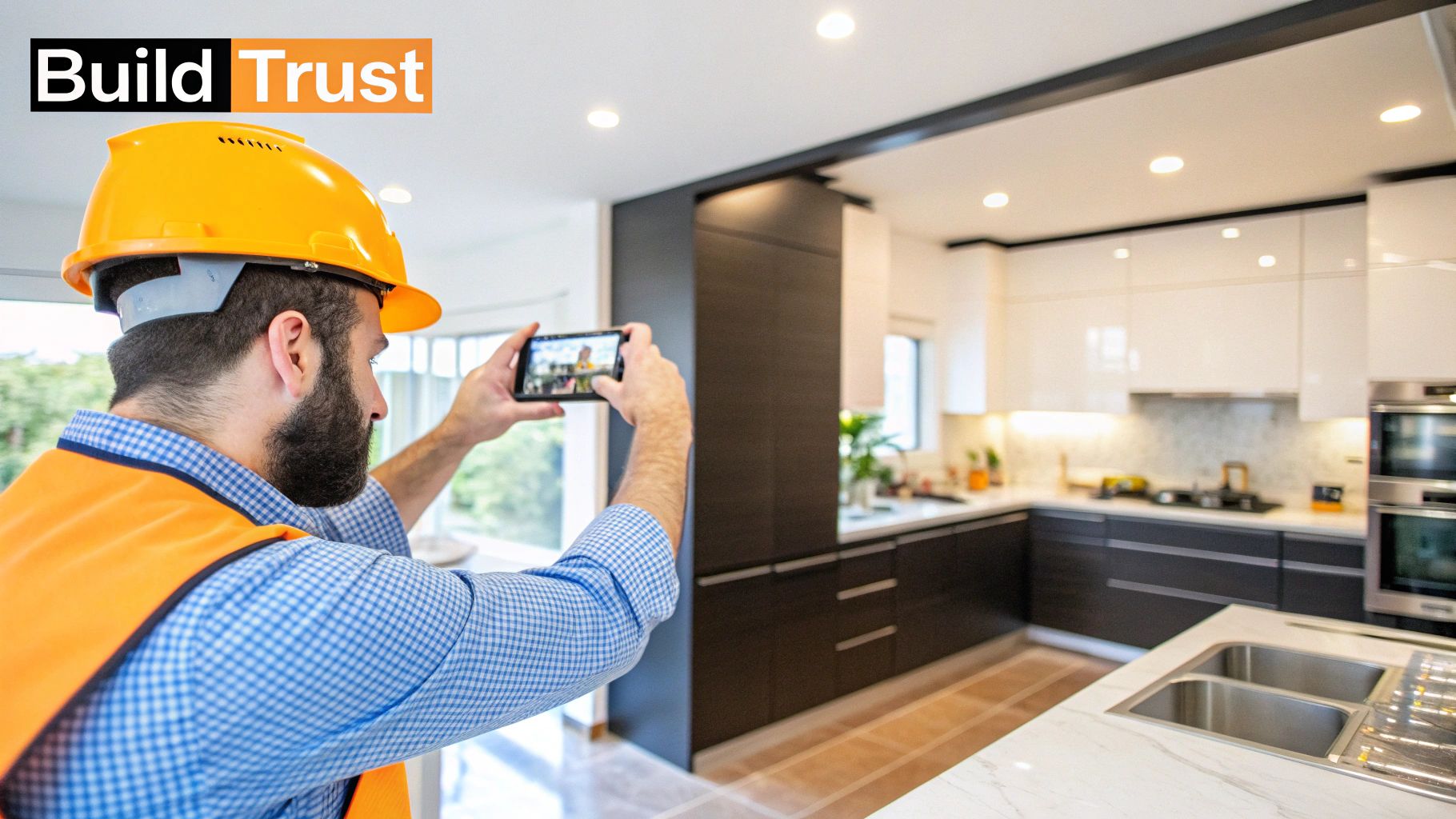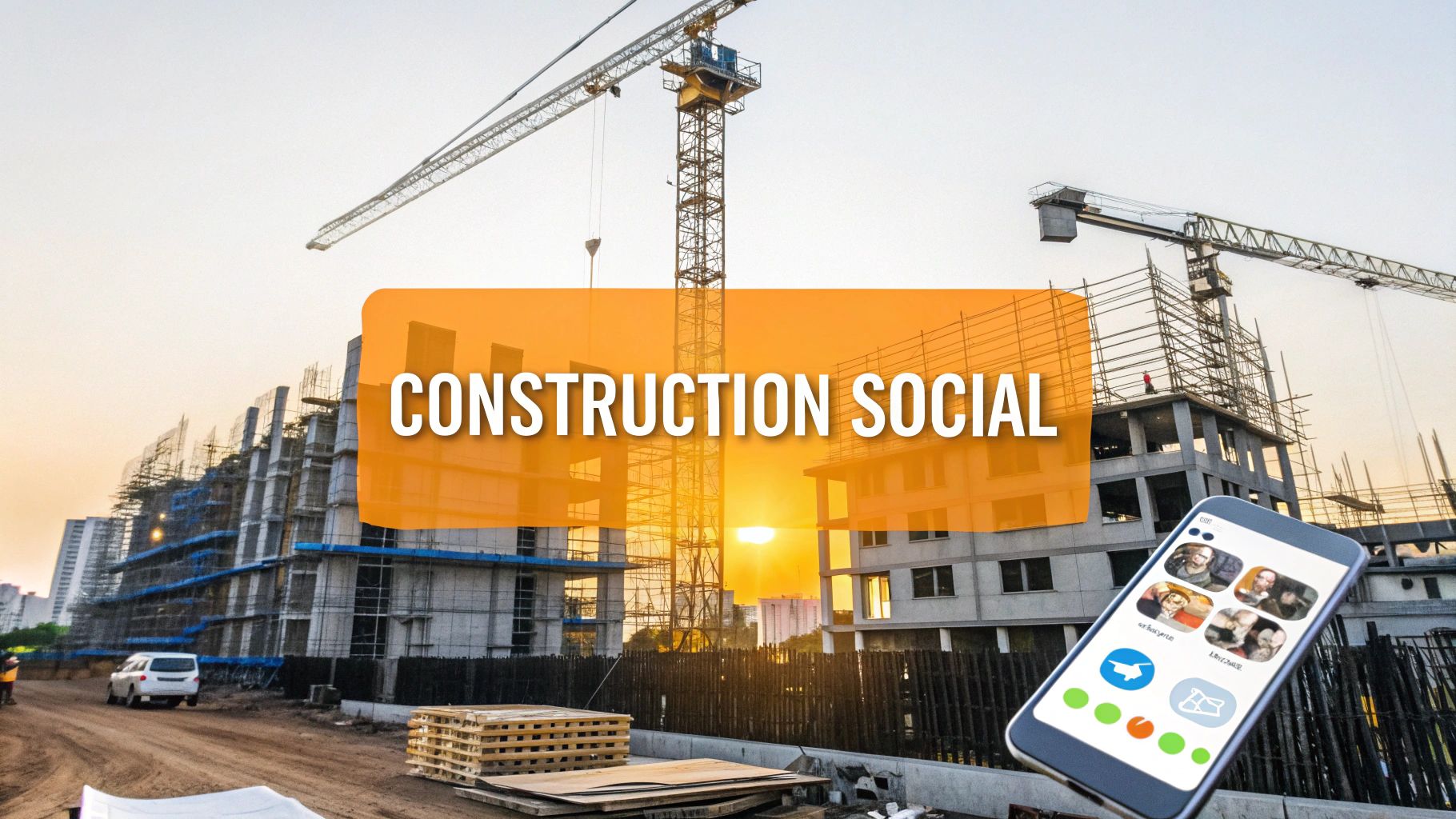


Social media is no longer a 'nice-to-have' for builders—it's one of the most important tools in your kit. A solid online plan is essential for showing your craftsmanship, building trust, and winning better work.
Think of your social media feed as your best finished project, on display 24/7. It's a constant showcase of your quality, attention to detail, and professionalism. Word-of-mouth will always be gold, but a strong social presence proves that reputation to a much wider audience.
It’s all about building trust from the first click. When a potential client hears your name, they look you up online. A professional, active feed signals you're a serious, credible business that takes pride in its work. An outdated profile—or no profile at all—plants a seed of doubt.
Your online activity translates directly into real-world results. A well-managed social media account isn't just for show; it's a lead-generation machine, working for you around the clock.
Here’s how it helps you win more business:
An effective small business social media strategy turns this potential into a real asset. It gives you a clear roadmap for converting online visibility into business growth.
Just as you use modern tools on-site, social media is the modern tool for building your business's reputation.

Your digital tools are now just as essential to a project's success as the ones you have on-site.
A strong social media presence doesn't just show people what you build; it shows them how you build. It’s proof of your process, your standards, and your commitment to quality.
A social media strategy gives you the power to shape your own story, connect directly with the people you want to work with, and build a brand that stands above competitors.
Jumping onto every social media platform is a waste of time. To win work, you need to be smart about it. Put your energy where your ideal clients, partners, and future employees are spending their time.
Think of it like picking a tool from the ute. You wouldn't grab a sledgehammer for a picture frame. Each platform has its own job, and using it the right way gets results.
For most New Zealand construction companies, it comes down to three main players: Facebook, Instagram, and LinkedIn. Each one talks to a different crowd and helps you hit different business goals. Getting this right is the difference between just posting online and actually building a pipeline of work.
Let's break down how each one can work for you.
Facebook is still a giant in New Zealand, with a massive 4.47 million users. This makes it essential for reaching local homeowners and building a community around your brand. To see the full picture of platform use in NZ, check out this detailed analysis by Daring Digital.
Use Facebook to:
Facebook is your digital neighbourhood. It’s where you connect with past clients, find new ones, and cement your reputation as the go-to builder in your area.
Instagram is all about visuals. For a builder, this is your chance to create a stunning portfolio that screams quality and craftsmanship. Let the finished product do the talking.
Your Instagram feed should be a highlight reel of your best work. Every photo and video is a testament to your skill, turning your profile into a powerful tool for attracting clients who value quality.
It's the perfect spot to show off the clean lines of a new architectural home in Tauranga or the details of a kitchen renovation. High-quality photos and short, sharp videos are what matter here.
Instagram is best for:
Think of LinkedIn as your online boardroom. It’s a professional space, ideal for connecting with commercial clients, architects, developers, and other partners. This isn't the place for casual site photos; it's for showcasing your business's professionalism and expertise.
Use LinkedIn to:
Here's a quick rundown to help you decide where to focus.
A quick comparison to help you decide where to invest your time based on your goals.
By treating each platform as a specialised tool, you put your time where it delivers the best return. This ensures your social media doesn't just look good—it helps you win the work you want.

What should a builder actually post on social media? This isn't about being an influencer. It's about creating a portfolio that proves your skill, builds trust, and gives potential clients the confidence to call you.
Your content needs to work for you by showcasing the quality you deliver. The goal is to post things that make someone stop scrolling and think, "That's the kind of builder I want."
Treat your social media feed like you're giving a client the final walkthrough. Every post is a chance to point out the details that set your work apart.
The most powerful content for a builder is the before-and-after shot. It’s a simple, visual story that instantly communicates your value without a lot of text.
This format just works. It shows a clear transformation, proving you solve problems and deliver incredible results. A great before-and-after of a kitchen renovation tells a more compelling story than words ever could.
To make them stand out:
This simple technique is one of the fastest ways to build credibility online.
Photos are great, but video brings your work to life. A short, authentic video walkthrough of a finished project lets people feel the space and appreciate the quality of your finish.
You don't need a production crew. A steady hand and a good smartphone are all you need to film a quick tour.
Think of a video walkthrough as your digital handshake. It’s personal, authentic, and it gives people a real feel for the pride you take in your craft.
Walk through the space, point out specific details like a perfectly mitred joint or a clever cabinetry feature, and talk about the project. This informal approach feels genuine and builds a strong connection.
Don't forget the people and the process behind the finished product. Introducing your skilled team or showing the high-quality materials you use adds layers of trust and professionalism.
This behind-the-scenes content shows you're not just building houses; you're running a professional operation built on expertise and quality. It’s a key part of construction social media that many builders overlook.
Consider posting things like:
These posts reinforce the message that you’re a trustworthy, high-calibre business. If you're looking for more ideas, we have a complete guide with more detail on builder content creation that helps win projects.
For this kind of visual storytelling, Instagram is a powerhouse. It’s built for high-quality images and video, making it the perfect place to build your visual portfolio.
In New Zealand, Instagram's influence is massive. The platform has 2.5 million users, which is 47.8% of our total population. More importantly, nearly 59% of adults in the country use it, making it an ideal channel for reaching residential clients.
By focusing on these core content types—before-and-afters, video walkthroughs, and behind-the-scenes glimpses—you create a powerful and professional online presence. Each post becomes another piece of evidence of your skill, systematically building the trust you need to win your next job.
Let's be real. You’re a builder. Your job is on-site, not on your phone figuring out what to post. The good news? It doesn't have to be. Building a professional online presence doesn't require you to live online—it just needs a smart, simple system.
The key is consistency over intensity. It's far better to share two quality posts a week, every week, than to drop ten posts in one go and then disappear for a month. Consistency builds trust and keeps you top-of-mind.
A little planning goes a long way. By setting aside a small amount of time, you can get your social media working in the background, bringing in leads while you get on with the real work.
The most effective way to manage your construction social media is content batching. The idea is simple: instead of scrambling for something to post every day, you plan and create your content for the next week or two in one session.
Think of it like pre-nailing frames in the workshop. You do the detailed work upfront, which makes on-site assembly quicker and smoother. Batching your content is the same principle.
By setting aside a couple of hours once a month for content batching, social media stops being a daily headache. This system lets you run your business without your online presence falling flat.
This approach ends the daily "what do I post?" panic. It ensures your updates are thoughtful and professional, not rushed. It also means your feed won't go quiet just because you're busy on a big project.
Once you’ve got a folder of great posts ready, the next step is automation. Scheduling tools let you load everything up, set the dates and times, and let it run. You set it once, and the platform handles the rest.
This guarantees your business stays active and visible online, even when you're coordinating subbies or taking a long weekend.
Here are a few straightforward tools perfect for tradies:
Here’s a practical system you can adapt for your business. It's designed to take just a couple of hours every fortnight.
That’s it. Following this simple loop means you'll maintain a strong, professional online presence without it taking over your day. Of course, for those who’d rather not touch it at all, professional social media management in NZ can take this entire system off your plate.

Likes and comments are nice, but paid projects are what keep the lights on. The real power of social media for construction is turning a casual scroller into a serious project enquiry. This is where your online efforts start feeding your bottom line.
A good-looking feed shows what you can do, but without a clear path for potential clients, it’s just a pretty gallery. The trick is to build a simple funnel that guides people from admiring a photo to booking a chat with you.
It starts by making it incredibly easy for them to take that next step. You have to tell them what to do.
Every post needs a job. A Call-to-Action (CTA) is a simple, direct instruction that tells your audience what you want them to do next. It removes the guesswork and gives them a nudge to get in touch.
Don’t overcomplicate it. Your CTAs should be friendly, obvious, and focused on solving a potential client’s problem.
Here are a few practical examples for builders:
The best CTAs are low-pressure and high-value. They offer a helpful, easy next step, making it feel natural for a potential client to start a conversation.
This small habit can turn your posts from passive portfolio pieces into active lead-generation tools. It’s the difference between someone thinking, "That looks great," and actually thinking, "I should message these guys."
When messages start rolling in, how you respond is everything. A quick, professional reply reinforces the quality and reliability your feed projects. This is your first real interaction—your chance to build trust.
Have a simple system for sorting serious leads from casual tyre-kickers. Not every message will be a hot lead, and that’s fine. Your job is to spot the serious ones and move the conversation forward.
For example, if someone asks a specific question about a past project, that’s a strong buying signal. Your goal should be to get the chat off social media and onto a phone call or email. A simple reply like, "Great question. The best way to run through the details for your project is a quick phone call. What’s the best number to reach you on?" works well.
Your social media funnel doesn't need to be complex. Think of it as a logical path that helps potential clients get the information they need.
Here’s what that looks like:
This straightforward system turns your social media from an online portfolio into a reliable source of quality project leads.
Social media analytics can be confusing. The good news? For a construction business, you can safely ignore most of them. Forget vanity stats like follower count—focus on the numbers that tell you if your online efforts are putting projects in the pipeline.
The real goal is to get people to take the next step: visiting your website, calling you, or sending a message. That’s what we need to measure. If a metric doesn’t point toward a new lead, it’s probably just noise.
Let’s zero in on a few key performance indicators (KPIs) that show real intent. These are the signs that your social media is actively working for you. For a deeper look at what success looks like, this guide on a social media KPI framework is a great resource.
Here are the core numbers you should watch:
Tracking these core metrics is like reading a blueprint for your marketing. It shows you exactly what’s working, what’s not, and where to put your energy to get the best results.
By focusing on these practical indicators, you can see the return on your time. You’ll know which posts are sparking conversations and which are falling flat, allowing you to double down on what works. This turns your social media into a reliable tool for business growth.
Jumping into social media for your building company can feel like a minefield. Here are straight answers to the questions we hear most often from builders.
This is the big one. The most common hurdle for builders is time. But with a smart system, it takes less time than you think. You don’t need to be glued to your phone every day.
The secret is content batching—setting aside a few hours to get a couple of weeks' worth of posts sorted. With this approach, you can run your social media in just a few hours a month. Remember, the goal is consistency, not constant activity.
Professional photos will always look best, but you don't need them to get started. The cameras on modern smartphones are incredible and more than capable of capturing sharp, high-quality images and video on the job site.
It's not about the gear; it’s about good lighting and a clean lens. Focus on capturing your craftsmanship clearly, and your phone will handle the rest. Later, investing in a professional shoot for a standout project is a great way to take your brand to the next level.
It’s rare, but it can happen. The worst thing you can do is ignore it or get into an argument. A calm, professional reply is always the way to go.
If it’s genuine feedback, thank them and shift the conversation out of the public eye. Something like, "Thanks for letting us know. Could you please send us a direct message with the details so we can look into this for you?" works perfectly. If it’s just spam or a troll, don’t engage—just delete the comment and block them.
A professional and calm response to a negative comment can actually build more trust than a dozen positive ones. It proves you’re accountable and committed to client satisfaction.
Handling criticism with grace turns a potential negative into a public display of your professionalism. It shows everyone you stand by your work and are a builder people can rely on.
At Onsite Media, we help builders turn their craftsmanship into a powerful online brand. If you're ready to look as good online as you do on site, let's talk. Learn more about how we build brands at https://onsitemedia.co.nz.

